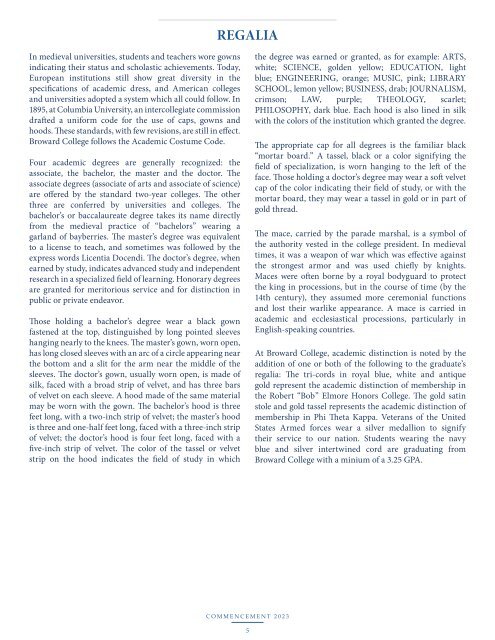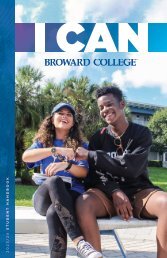commencement_fall23_flipbook
Broward College Fall 2023 Commencement Ceremony Book
Broward College Fall 2023 Commencement Ceremony Book
You also want an ePaper? Increase the reach of your titles
YUMPU automatically turns print PDFs into web optimized ePapers that Google loves.
REGALIA<br />
In medieval universities, students and teachers wore gowns<br />
indicating their status and scholastic achievements. Today,<br />
European institutions still show great diversity in the<br />
specifications of academic dress, and American colleges<br />
and universities adopted a system which all could follow. In<br />
1895, at Columbia University, an intercollegiate commission<br />
drafted a uniform code for the use of caps, gowns and<br />
hoods. These standards, with few revisions, are still in effect.<br />
Broward College follows the Academic Costume Code.<br />
Four academic degrees are generally recognized: the<br />
associate, the bachelor, the master and the doctor. The<br />
associate degrees (associate of arts and associate of science)<br />
are offered by the standard two-year colleges. The other<br />
three are conferred by universities and colleges. The<br />
bachelor’s or baccalaureate degree takes its name directly<br />
from the medieval practice of “bachelors” wearing a<br />
garland of bayberries. The master’s degree was equivalent<br />
to a license to teach, and sometimes was followed by the<br />
express words Licentia Docendi. The doctor’s degree, when<br />
earned by study, indicates advanced study and independent<br />
research in a specialized field of learning. Honorary degrees<br />
are granted for meritorious service and for distinction in<br />
public or private endeavor.<br />
Those holding a bachelor’s degree wear a black gown<br />
fastened at the top, distinguished by long pointed sleeves<br />
hanging nearly to the knees. The master’s gown, worn open,<br />
has long closed sleeves with an arc of a circle appearing near<br />
the bottom and a slit for the arm near the middle of the<br />
sleeves. The doctor’s gown, usually worn open, is made of<br />
silk, faced with a broad strip of velvet, and has three bars<br />
of velvet on each sleeve. A hood made of the same material<br />
may be worn with the gown. The bachelor’s hood is three<br />
feet long, with a two-inch strip of velvet; the master’s hood<br />
is three and one-half feet long, faced with a three-inch strip<br />
of velvet; the doctor’s hood is four feet long, faced with a<br />
five-inch strip of velvet. The color of the tassel or velvet<br />
strip on the hood indicates the field of study in which<br />
the degree was earned or granted, as for example: ARTS,<br />
white; SCIENCE, golden yellow; EDUCATION, light<br />
blue; ENGINEERING, orange; MUSIC, pink; LIBRARY<br />
SCHOOL, lemon yellow; BUSINESS, drab; JOURNALISM,<br />
crimson; LAW, purple; THEOLOGY, scarlet;<br />
PHILOSOPHY, dark blue. Each hood is also lined in silk<br />
with the colors of the institution which granted the degree.<br />
The appropriate cap for all degrees is the familiar black<br />
“mortar board.” A tassel, black or a color signifying the<br />
field of specialization, is worn hanging to the left of the<br />
face. Those holding a doctor’s degree may wear a soft velvet<br />
cap of the color indicating their field of study, or with the<br />
mortar board, they may wear a tassel in gold or in part of<br />
gold thread.<br />
The mace, carried by the parade marshal, is a symbol of<br />
the authority vested in the college president. In medieval<br />
times, it was a weapon of war which was effective against<br />
the strongest armor and was used chiefly by knights.<br />
Maces were often borne by a royal bodyguard to protect<br />
the king in processions, but in the course of time (by the<br />
14th century), they assumed more ceremonial functions<br />
and lost their warlike appearance. A mace is carried in<br />
academic and ecclesiastical processions, particularly in<br />
English-speaking countries.<br />
At Broward College, academic distinction is noted by the<br />
addition of one or both of the following to the graduate’s<br />
regalia: The tri-cords in royal blue, white and antique<br />
gold represent the academic distinction of membership in<br />
the Robert “Bob” Elmore Honors College. The gold satin<br />
stole and gold tassel represents the academic distinction of<br />
membership in Phi Theta Kappa. Veterans of the United<br />
States Armed forces wear a silver medallion to signify<br />
their service to our nation. Students wearing the navy<br />
blue and silver intertwined cord are graduating from<br />
Broward College with a minium of a 3.25 GPA.<br />
COMMENCEMENT 202 3<br />
5
















